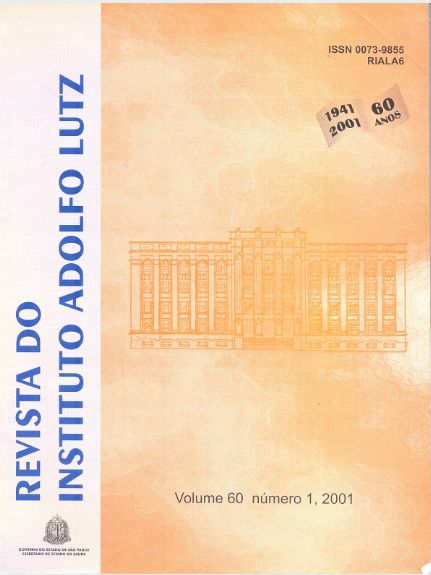Abstract
A partial chemical characterization of Lonchocarpus muehlbergianus Hassl. seeds
(Leguminosae-Faboideae family) was carried out. The fruits were obtained from State Park “Morro do
Diabo”, Teodoro Sampaio, SP, Brazil. Moisture, ash and lipid determination followed the gravimetric methods;
that of protein was done according to Kjeldahl digestion process and the dietary fiber, the A.O.A.C.
enzymatic-gravimeter method, modified by LEE et al. Inorganic elements and fatty acids were determined
through ICP-AES and GC, respectively. The seeds showed a high lipid (26,8 g/100g), protein (25,9 g/100g)
and dietary fiber (18,4 g/100g) content. The major fatty acids components of the oily fraction were palmitic
(11,65%), oleic (56,0%) and linolenic (12,9%), an essential w-3 fatty acid. Among the inorganic elements,
high levels of P (0,214 g/100g), Mg (0,135 g/100g), K (0,458 g/100g) and low concentrations of Al
(47 mg/g), Zn (33 mg/g) and Fe (23 mg/g) were found. The results favour the use of the seeds for enrichment
of rations and/or food products, nevertheless it suggested an investigation about rotenone, reported as a
toxic substance present at leaves and roots of the Lonchocarpus genus.
References
1. American Oil Chemists’Society. Official methods and recommended practices of the American Oil Chemists’ Society. 4th ed. Champaign, A.O.C.S., 1990. (A.O.C.S. Recommended Practice C.d. 1c-85).
2. Asp, N.G. et al. Rapid enzymatic assay of insoluble and soluble dietary fiber. J. Agric. Food Chem., 31: 476-482, 1982.
3. Barroso, G. M. Sistemática de angiospermas do Brasil. Viçosa. 1984, v.2. 377p.
4. Brasil, Leis, decretos, etc. Portaria nº 33/98 da Secretaria de Vigilância Sanitária do Ministério da Saúde. Diário Oficial, Brasília, 30 mar. 1998. Seç. I, Nº 60-E, p. 5-6. Adota os valores constantes das tabelas do anexo desta portaria como níveis de IDR (Ingestão Diária Recomendada) para as vitaminas, minerais e proteínas.
5. Brasil, Leis, decretos, etc. Portaria nº 695/98 da Secretaria de Vigilância Sanitária do Ministério da Saúde. Diário Oficial, Brasília, 24 set. 1998. Seç. I, nº 183-E, p. 3. Aprova o Regulamento Técnico: “Princípios Gerais para o Estabelecimento de Níveis Máximos de Contaminantes Químicos em Alimentos” e seu Anexo: “Limites máximos de tolerância para contaminantes inorgânicos”.
6. Brasil, Leis, decretos, etc. Resolução nº 482/99 da Diretoria Colegiada da Agência Nacional de Vigilância Sanitária. Diário Oficial, Brasília, 13 out. 1999. Seç. I, nº 196-E, p. 82-87. Aprova o Regulamento Técnico referente a Óleos e Gorduras Vegetais, constante do anexo desta Resolução. (Anexo 13: Azeite de oliva).
7. De Angelis, R.C. Fisiologia da nutrição: fundamentos para nutrição e desnutrição. São Paulo, EDART, 1977, v. 1, cap. 4, p. 44.
8. Favier, J.C. Repertório geral dos alimentos: tabela de composição. 2ª ed. São Paulo, Roca, 1999, p. 572.
9. Fundação Brasileira de Geografia e Estatística (IBGE). Estudo nacional da despesa famíliar (ENDEF). Rio de Janeiro, 1977. [Dados preliminares, t. 1, p. 36].
10. Hernández, T.; Hernández, A.Y.; Martinez, C. Fibra alimentaria: concepto, propiedades y métodos de análisis. Rev. Alimentaria, 1(6): 19-29, 1995.
11. Instituto Adolfo Lutz. Normas analíticas do Instituto Adolfo Lutz. v.1: métodos químicos e físicos para análise de alimentos. 3ª ed. São Paulo, IMESP, 1985, p. 22, 27, 28, 42, 43, 44, 45, 266.
12. Kaloyeras, S.A. Rancidity as a factor in the loss of viability of pine and other seeds. J. Am. Oil Chem. Soc., 35: 176-179, 1958.
13. Lago, R.C.A. et al. Estudos preliminares das sementes e do óleo de cinco espécies da Amazônia. Acta Amazonica, 16/17 (nº único): 369-376, 1986/87.
14. Lee, S.C; Prosky, L.; Devries, J.W. Determination of total, soluble, and insoluble dietary fiber in foods. Enzymatic-gravimetric method,MÊS-TRIS Buffer: collaborative study. J. Assoc. Off. Anal. Chem. Int., 75: 395-416, 1992.
15. Lewis, G.P. Legumes of Bahia. Kew. Richmond, Publications Department Royal Botanic Gardens, 1987. 369p.
16. Lorenzi, H. Árvores Brasileiras: manual de identificação e cultivo de plantas arbóreas nativas do Brasil. Nova Odessa, Plantarum, 1992. 351p.
17. Mahan, L.K.; Stump, S.E. Krause-Alimentos, nutrição e dietoterapia. 9ª ed. São Paulo, Roca, 1999. p. 1097.
18. Markert, B. Presence and significance of naturally occurring chemical elements of the periodic system in the plant organism and consequences for future investigations on inorganic environmental chemistry in ecosystems. Vegetatio, 103: 1-30, 1992.
19. Marsiglia, D.A.P.; Garbelotti, M.L. I Curso de fibra alimentar: teórico e prático. São Paulo, Instituto Adolfo Lutz, 1999. P. 4. 20. Matsumura, F. Toxicity of insecticides. New York, Plenum Press,1985. 598p.
21. Mors, W.B.; Rizzini, C.T. Useful Plants of Brazil. San Francisco, Holden-Day, 1966. p. 97-98.
22. Popinigis, F. Fisiologia da semente. 2ª ed. Brasília, Agiplan, 1985. 289p.
23. Saastamoinen, M.; Kumpulainen, J.; Nummela, S. Genetic and environmental variation in oil content and fatty acid composition of oats. Cereal Chem., 66(4):269-300, 1989.
24. Silva, C.R.; Silva, H.C.; Dutra de Oliveira, J.E. Conteúdos de celulose, hemicelulose e lignina em dieta hospitalar hipocalórica. Alim. Nutr., 2:65, 71, 1990.
25. Stansby, M.E.; Lemon, J.M. Quantitative determination of oil in fish flesh. Ind. Eng. Chem., 9(7): 341-343, 1937.
26. The Merck Index. The Merck Index: an Encyclopedia of Chemicals, Drugs and Biologicals. Budavari, S. editor. 11th ed. Rahway, Merck & Co., 1989. p. 1314-1315.
27.Vallilo, M.I.; Tavares, M.; Aued-Pimentel, S. Composição química da polpa e da semente do fruto do cumbaru (Dipteryx alata Vog.) – Caracterização do óleo da semente. Rev. Inst. Flor., 2(2): 115-125,
28.Vallilo, M.I. et al. Lecythis pisonis Camb. nuts: oil characterization, fatty acids and minerals. Food Chem., 66: 197-200, 1999.

This work is licensed under a Creative Commons Attribution 4.0 International License.
Copyright (c) 2001 Instituto Adolfo Lutz Journal
